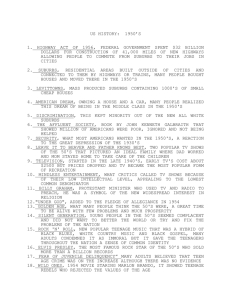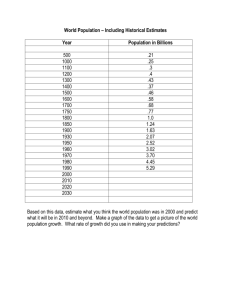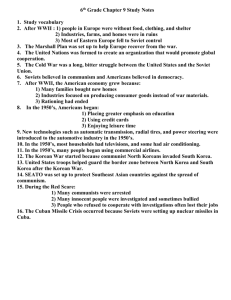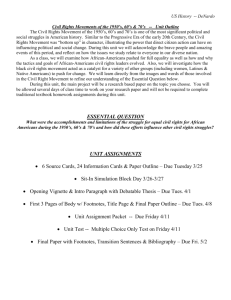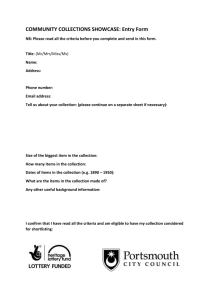File
advertisement
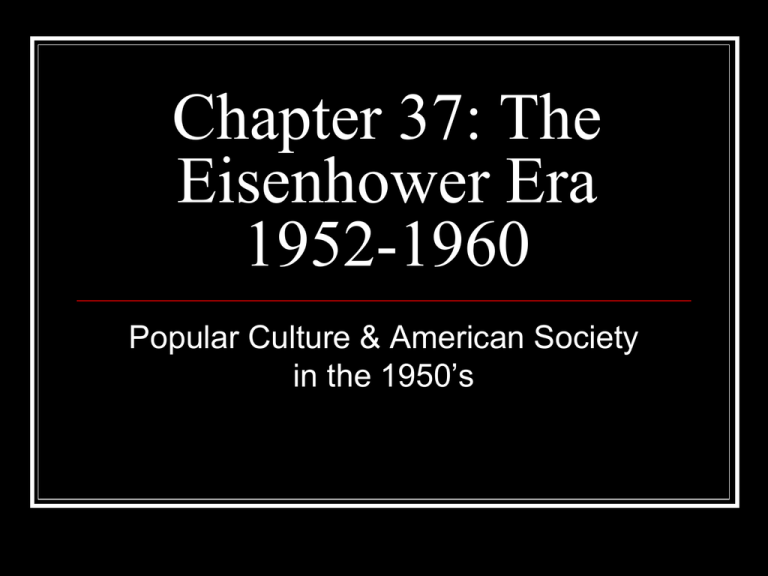
Chapter 37: The Eisenhower Era 1952-1960 Popular Culture & American Society in the 1950’s 1950’s Popular Culture Servicemen’s Re-adjustment Act, 1944 Also known as the “G.I.” Bill Huge impact on American society & economy in the 1950’s Opportunities for WWII Veterans G.I. Bill Offered… 1. University education 2. Vocational Training 3. Small business loans 3. Home loans Universities Award 2x’s as many degrees in 1950 as opposed to 1940 8 million vets used G.I. funds to attend Colleges &Universities 1950’s Prosperity Credit Cards: Diner’s Club, American Express, 1958 Low interest home loans Who is the 1950’s The Middle Class? 1. At least some college education 2. Men work – white collar jobs, or blue collar management 3. Own 2 cars 4. Own suburban home 5. Stay at home wife, 2 kids 6. mostly white “Auto Mania” Cars Facilitate movement 85% of homes built in 1950’s built in the suburbs. Growth of Suburbs Tract homes built en masse in the 1950’s “Levittowns”emerged (planned communities in suburbs) Levitt Construction company- east coast Growth of Suburbs Average home price 1950’s: $11,500 - $14,500 Lakewood, Ca- 1st Planned Community in L.A. STEP 1 STEP 2 Lakewood, Ca- 1st Planned Community in L.A. STEP 3 STEP 4 “White Flight” White, middle class Moved to suburbs Loans denied to minorities 60% of Americans owned homes by end of 50’s National Highway Act 1956 “Interstate” Highways unified nation $40 billion 41,000 mile construction project Popular Culture Along Highways The emergence of fast food chains, motels, shopping malls Baby Boom 50-75 million babies born between 19461964 “at home” mothers depicted in popular culture Women in the 1950’s 1950’s Middle Class ideal: stay at home mom Husband earns enough money so wife does not have to work Television Culture 9 in 10 homes had T.V. sets by 1960 Facilitated the spread of “fads” 1950’s Fads Hula Hoops! Records! Barbie! Telephone booth stuffing! Rock N’ Roll Term coined by DJ Alan Freed 1951 Controversial Society concerned about teenagers Rebellious Youth in Film James Dean “Rebel Without a Cause” (1955) Marlon Brando – “ The Wild One” (1954) Disneyland Opened in Anaheim, CA 1955 Price of admission: $1 The Construction of Disneyland… Does Disneyland represent the social idealism of the 1950’s?? Poverty and Urban Blight By 1960, 35 million people lived below poverty line Inner city deteriorated into slums Reality of the ignored 1950’s Reality: 1. Racism, discrimination, segregation 2. Popular Culture depicts white middle class experience 3. Poverty, urban flight, inequality
